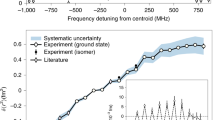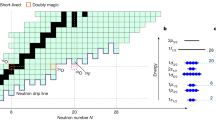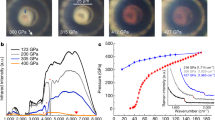Abstract
RECENTLY two groups1,2 have reported finding experimental evidence for an unexpectedly high rate of nuclear fusion at room temperature during the process of electrolytic deposition of deuterium on palladium1,2 and titanium2. To achieve the rate of neutron production (∼10−23s−1 per deuteron pair) cited in ref. 2 (and a fortiori, that inferred in ref. 1) requires the solid-state environment to produce either an unusual enhancement of the fusion reaction rate or a large suppression of the Coulomb barrier between deuterons. The latter would presumably arise from some kind of sophisticated many-body screening effect in Pd or Ti, perhaps associated with quasiparticles of large effective mass2. Here we point out that within the framework of the lowest-order Born-Oppenheimer approximation, a very severe constraint is imposed on all such screening mechanisms in solids in equilibrium by the observable binding affinity of 4He atoms for the metal in question. Unless the latter is quite anomalous, the Coulomb barrier penetration in a solid in equilibrium cannot be enhanced anywhere near the magnitude required to explain the fusion rates inferred from the experiments.
This is a preview of subscription content, access via your institution
Access options
Subscribe to this journal
Receive 51 print issues and online access
$199.00 per year
only $3.90 per issue
Buy this article
- Purchase on Springer Link
- Instant access to full article PDF
Prices may be subject to local taxes which are calculated during checkout
Similar content being viewed by others
References
Fleischmann, M., Pons, S. & Hawkins, M. J. J. electroanalyt. Chem. 261, 301–308 (1989); and erratum, 263, 187–188 (1989).
Jones, S. E. et al. Nature 338, 737–740 (1989).
Zel'dovich, Ya. B. & Gershtein, S. S. Sov. Phys. Usp. 3, 593–623 (1961).
Van Siclen, C. D. & Jones, S. E. J. Phys. G 12, 213–221 (1986).
Koonin, S. E. & Nauenberg, M. Nature 339, 690–691 (1989).
Doede, J. H. Phys. Rev. 132, 1782–1799 (1963).
Lässer, R. & Powell, G. L. Phys. Rev. B34, 578–586 (1986).
Bach, P. Radiation Effects (GB) 78, 77–86 (1983).
Leggett, A. J. & Baym, G. Phys. Rev. Lett. (submitted).
Author information
Authors and Affiliations
Rights and permissions
About this article
Cite this article
Leggett, A., Baym, G. Can solid-state effects enhance the cold-fusion rate?. Nature 340, 45–46 (1989). https://doi.org/10.1038/340045a0
Received:
Accepted:
Issue Date:
DOI: https://doi.org/10.1038/340045a0
This article is cited by
-
Theories of Variable Mass Particles and Low Energy Nuclear Phenomena
Foundations of Physics (2014)
-
Possible theories of cold fusion
Il Nuovo Cimento A (1994)
-
Critical review of theoretical models for anomalous effects in deuterated metals
International Journal of Theoretical Physics (1994)
-
Measurement and analysis of neutron and gamma-ray emission rates, other fusion products, and power in electrochemical cells having Pd cathodes
Journal of Fusion Energy (1990)
-
Measurements of neutron emission induced by muons stopped in metal deuteride targets
Journal of Fusion Energy (1990)
Comments
By submitting a comment you agree to abide by our Terms and Community Guidelines. If you find something abusive or that does not comply with our terms or guidelines please flag it as inappropriate.



